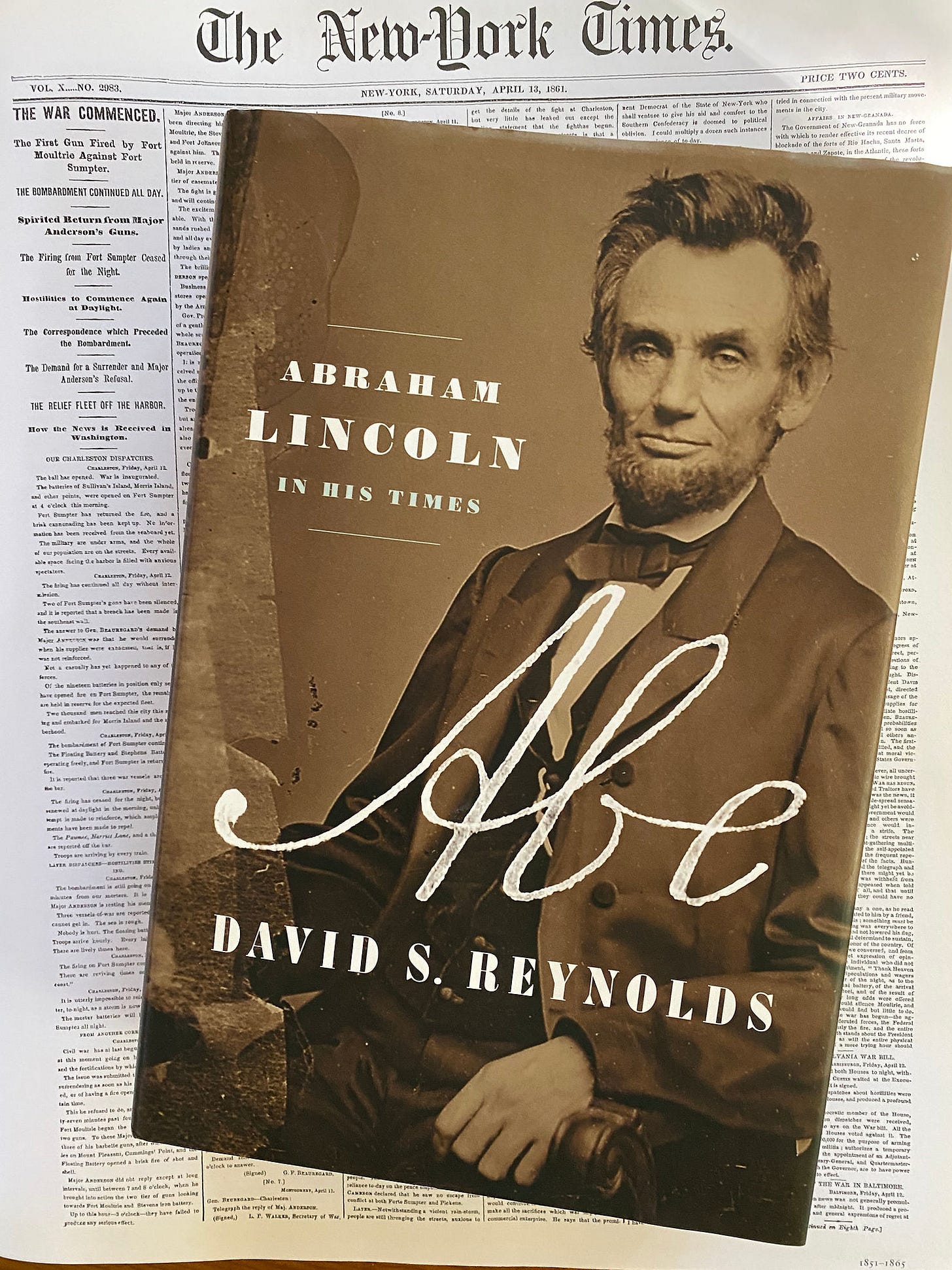Review of ABE: Abraham Lincoln in his times
A long, lovely and timely biography of Abraham Lincoln
I realize that it is a bit grandiose of me to think I can convince readers to read a 934-page biography of Abraham Lincoln. Most readers I suspect are some version of myself. You have been saturated in Lincoln. Despite the universal awe and veneration, despite the extraordinary Memorial, despite the film clip of Martin Luther King’s speech on its steps … despite all of this and so much more, it feels a bit much to commit yourself to over 900 pages, much of which you suspect you have either studied, heard or read. At least, that was the space I occupied as I stood over the book and examined it for the third straight day at a bookstore in Sag Harbor in October. Needless to say, I bought it and three months later I finished it with the deep bittersweet feeling that comes with a poignant goodbye. Remarkably, it “refreshed” Lincoln in such a relevant and powerful way. It made him even more extraordinary through getting in touch with what was ordinary and human about him. My book notes could go on for pages and I considered putting them together for this review then realized that I would only barely scratch the surface of this splendid book. There is so much in it. It is written with an open mind in an eminently accessible style. It is filled with pitch-perfect illustrations and photographs and is a true cornucopia of quotations, profiles and cultural history. Reynolds made his name with a vast cultural history based biography of Walt Whitman. He tells his story of Lincoln through the same cultural history filter with Walt lurking throughout. You get to know everybody so well. Mary Todd Lincoln is reconstructed in a long overdue fashion without any feminist resentment to tarnish her true self. The homosexual revisions are left in the dust of context, as is most every attempt that has been made to take this man down. This is accomplished with grace and empathy and makes one realize that anyone out there who wants to “cancel’ Lincoln needs to find a different line of work. It is a powerful, persuasive but humble piece of scholarship. I suspect Lincoln himself would greatly approve.
Here are a few (a “very few”) of the pieces from the vast mosaic that this book is.
He never drank in a world where the consumption of alcohol was four times today’s level.
He grew up in Daniel Boone territory and their families knew each other.
He was forever obsessed with the “transient” nature of life and kept fatalism at bay with humor, hard work and seasoned idealism.
His favorite literary art was POETRY – by a major league mile.
His strength was the stuff of legend.
He gained a life long loyalty of the often violent “gangs” he grew up with.
He refused to shoot wildlife.
He tried or judged 5000 cases before being President.
20% of those cases involved spousal abuse or similar “family” cases.
The sport of “eye gouging” was a vivid part of his upbringing.
He did split rails.
His hatred of slavery was early and genuine.
His belief in the equality of the black man evolved like much of America.
He believed in God … maybe not in Jesus.
He was even funnier than you think.
His life was filled with terrible loss.
He was a doting father who lost two of his four children including his favorite, Tad, in the winter of 1862, thanks to the filthy conditions surrounding the White House.
Mary redecorated a run down White House and brought much f it to its current shape and was vilified for it.
Mary was a clothes horse.
Along with poetry, it was Shakespeare, Melville, Emerson, Poe, Whitman …
All is endless stories had a point.
He had a temper and, particularly in his younger years, hurt people with his tongue and pen.
He believed in the “cosmic” nature of things – that we are all connected in some way, with each other and the earth.
Mary was a brave, very opinionated, anti-slavery advocate who loved Abe.
Politics then was filled with “Trump parades” and mob intimidation.
Race riots and lynching were not uncommon – in much of the North.
Free blacks were banned from settling in Lincoln’s Illinois.
The Jacksonian Democrats invented the rhetoric of Trump’s MAGA followers.
James Buchanon really was our WORST president.
He was responsible for UC Berkeley, Ohio State and Thanksgiving.
He was assassinated on Good Friday.
He had survived multiple assassination attempts and plots.
Speilberg’s Lincoln is dead accurate.
This is enough. The bullet points are a true scatter shot of what I annotated and mostly come from the first half of the book.
Finally, thinking about our current moment. Lincoln was obsessed with the importance of governing from the center. He believed that the extremes are where our democracy goes to die. He took this “centrist” philosophy and applied it to all parts of his life. He did not drink but was very suspicious of the righteousness of the temperance movement. Any cause (then labeled “isms”) that was lathered in righteousness he viewed with suspicion. Just like his “team of rivals” cabinet, he embraced all sorts of men and women from all walks of life with wildly different opinions. They each in their own way shaped the space from which he would emerge to save our country – which he did.
Abe: Abraham Lincoln in His Times
by David S. Reynolds (2020)
1088 pages


